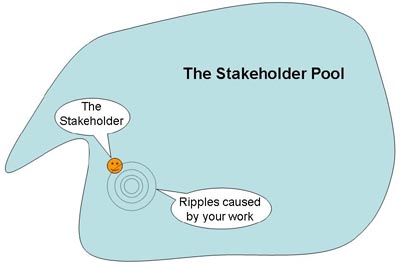When beetles battle beetles in a puddle paddle battle and the beetle battle puddle is a puddle in a bottle…
…they call this a tweetle beetle bottle puddle paddle battle muddle.
Excerpted from: Tweetle Beetles, ‘The Fox in Socks’, by Dr Seuss
The connection between a book written to be read to under 5s and business stakeholder management is the ‘puddle muddle’ otherwise known as the stakeholder pool. The challenge of managing stakeholders is a factor of the disturbance caused by dozens if not hundreds of battles most of which, the person attempting to efficiently manage his or her stakeholders has no control over whatsoever.
Most stakeholder management methodologies start by assessing the stakeholder from the perspective of the work. This is not unreasonable but can easily miss many important factors.

Figure 1: The Stakeholder Pool
Figure 1 shows ‘the stakeholder’ in the overall stakeholder pool being influenced by the ripples created by your battle in your part of the pool (your puddle). Unfortunately the stakeholder pool is a much bigger, more turbulent place.

Figure 2: the Stakeholder Pool with turbulence
Show some of the other disturbances in the pool and you start to see the stakeholder buffeted by waves and impacts from all directions, in Figure 2. ‘The stakeholder’ is continually being buffeted by waves from other projects, the organisation and many other influences. These other waves are one of the prime reasons stakeholder responses to your perfectly reasonable needs or suggestions are frequently so unpredictable. All of these influences, both current and past have helped shape the stakeholders perceptions and attitudes towards your industry, your organisation and ultimately, you.
Consequently, a single view point is really not sufficient! Effective stakeholder management needs an organisational approach. Successful stakeholder management requires all of the influences perceived by the stakeholder to be coordinated and authentic. And this can only be achieved by the organisation as a whole adopting mature, ethical stakeholder management as a core discipline.
Very little has been written about mature organisational stakeholder management until recently. To date, the focus of most papers have been one dimensional focusing on CRM and the ‘customer experience’ or one dimensional focusing on the relationship between the stakeholder and a project (or other organisational activity).
A new book, Stakeholder Relationship Management: A Maturity Model for Organisational Implementation, by Dr. Lynda Bourne takes this next step to define the interaction between the organisation as a whole and its stakeholders using the Stakeholder Relationship Management Maturity (SRMM®) model.
Effective and ethical stakeholder management cannot happen overnight and cannot happen in isolation. The preconceived perceptions of stakeholders towards your work are based on multiple experiences over an extended period of time, and the stakeholder-to-stakeholder conversations that occur outside of your hearing or control. To actively improve these conversations and create a positive and supportive stakeholder environment needs a long term consistent effort, organisation wide.
Bourne’s SRMM model offers a practical framework that can be used by organisations to build from ad hoc, single project attempts to manage stakeholders to a situation where stakeholder management is a core skill used by the organisation as a whole to maintain a competitive advantage. As with any culture change, this cannot happen overnight but at least Dr. Bourne’s new book provides a road map organisations can use to improve their management of stakeholder relationships to the benefit of both the stakeholders and the organisation.
Stakeholder Relationship Management: A Maturity Model for Organisational Implementation is published by Gower, ISBN: 978-0-566-08864-3
 Does Santa use the SRMM® maturity model to enhance his organisations stakeholder management practices?
Does Santa use the SRMM® maturity model to enhance his organisations stakeholder management practices?





